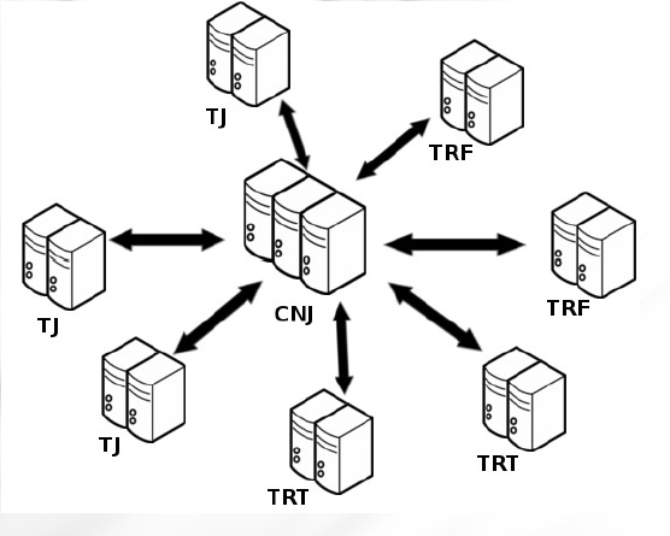1.
Introduction: the Research Project on Electronic Judicial Process (EJP) and Interoperability ^
2.
The context of the problem of Interoperability in Brazil ^
3.
Legislation on Brazilian E-Justice ^
4.
Main systems of Electronic Judicial Process operating in Brazil ^
E-SAJ – In use in State Courts of Sao Paulo and 7 other States.
PROJUDI – The former National Council of Justice – CNJ software, in use in the State Courts of Parana and 19 other States
E-PROC – In use in the Federal Courts of the 4th Region (Federal Justice Circuits for the States of Parana, Santa Catarina and Rio Grande do Sul) and State Courts of Tocantins – 3,0+ million of active lawsuits
PJe – The current National Council of Justice – CNJ software (proposed to be adopted by all Brazilian Courts)
These systems have a considerable size and power to process millions of judicial processes. For instance, the following table show some data about them:
| E-SAJ (Data from Dec. 2014) | 1,973,337 digital processes (active and stored) |
| PROJUDI (Data from Dec. 2014) Parana State Courts | Total registered cases: 3,856,418 |
| Total distributed processes: 3,827,265 | |
| Total active processes: 1,521,535 | |
| Total distributed appellations: 192,092 | |
| Total active lawyers: 61,958 | |
| Total parties with access to the system: 67,131 | |
| Projudi is implemented in all Parana State Districts. | |
| E-PROC (Data from Dec. 2014) | 3.031.102 digital processes |
PJE (no consolidated data)
Stages of PJe Implementation at the Brazilian States (up to 2013) – State Appellate Courts2
Stages of PJe Implementation at the Brazilian Sates (up to 2013) – Labor Appellate Courts3
5.
The problem of Interoperability of EJPs in Brazil ^
- Brazil has dozens of systems of Electronic Judicial Process systems;
- Systems are not interoperable between themselves and between Lower Courts, Appellate Courts and Superior Courts;
- Interoperability gaps between systems are mostly solved through solutions thought for paper based procedures;
- Lawyers must operate the same legal procedures in different systems.
5.1.
Two Models of Interoperability in progress in Brazil ^
Currently, in the mandate of the Justice Ricardo Lewandowski as president of the Council, the CNJ is assuming a diferent approach, the so called Virtual Office one, in which PJe can co-exist and work together with other systems. In this model the electronic judicial process system software is not so important. The most important feature is to follow the model of interoperability, as Figure 2 shows.
The last and most important result that we have in 2014 concerning interoperability is the already mentioned «Virtual Office» project. The National Council of Justice and the Brazilian Bar Association (OAB – «Ordem dos Advogados do Brasil» in Portuguese) are working together to develop a software that will integrate the EJPs of all Brazilian Courts and allow to the user one unified access to the Judicial Branch of government digital services. The main idea of this project is to allow lawyers, prosecutors and other agents involved with judicial processes to access and follow all their lawsuits in different Courts in just one virtual environment (a website or a standalone software), and not inside of each of the several Electronic Judicial Systems developed by each Brazilian Court, as it works today.
6.
The main goals of the Research Project ^
Another part of the research project involves both empirical and theoretical research. The main goals are:
- Quantify the interoperability capability of the main systems of electronic judicial process in Brazil through specific surveys and metrics;
- Formulate the semantics of the judicial processes;
- Interchange knowledge and experience with the projects of European Union in Interoperability, for instance: E-CODEX (e-Justice Communication via Online Data Exchange) and BIECPO (Building Interoperability for European Civil Proceedings Online).
6.1.
Point 1 – Quantifying the Interoperability of EJP ^
- Is the system interoperable with the EJS of superior and lower judicial instances?
- Is the system interoperable with software aimed at aiding the visually or hearing impaired?
- Is the system interoperable with several operational systems like Windows, OS X and Linux?
- Is the system interoperable with any web browser?
- Is the system interoperable with mobile phones and tablets (Android and iOS)?
- Is the system interoperable with the EJS of other Courts?
- Is the system externally interoperable with registers and other auxiliary organs to the Judiciary?
- Is the system interoperable with systems of Judicial fees payment?
- Which is the access of the user to the system: via login/password or digital certificate?
6.2.
Point 2 and 3 – Semantics of Judical Process and EJS and Interoperability in Comparative Law ^
Cesar Antonio Serbena, Professor of Philosophy of Law, Law School, Federal University of Paraná-Brazil, Santos Andrade Square 50, 80020-300 Curitiba, BR, cserbena@gmail.com; http://www.ejustica.ufpr.br
Luiz Henrique Krassuski Fortes, Law Clerk to a Federal Judge and Master of Laws Candidate at Federal University of Paraná-Brazil, Santos Andrade Square 50, 80020-300 Curitiba, BR, krassuski@gmail.com; http://www.ejustica.ufpr.br
- 1 For instance, in 2013 the STF decided 45.361 processes. Since 1989, the STF decided 1.348.750 processes. For more details see http://www.fgv.br/supremoemnumeros/visualizacoes/cfilter-stf/index.html.
- 2 For more details see http://www.cnj.jus.br/programas-de-a-a-z/sistemas/processo-judicial-eletronico-pje/mapas-de-implantacao.
- 3 For more details see http://www.cnj.jus.br/programas-de-a-a-z/sistemas/processo-judicial-eletronico-pje/mapas-de-implantacao.









